Dracaena draco ( Dragon Tree ) is sometimes also called the Dragon's Blood Tree because when the leaves or stems are cut, the sap is red. These plants are slow growing and very long-lived. Older plants have many branches and end up with an umbrella-like shape and flat on top. They are drought tolerant once established and prefer temperate to warm climate, a sunny position and well drained soil. This spectacular specimen plant is growing in a waterfront reserve on Sydney Harbour.
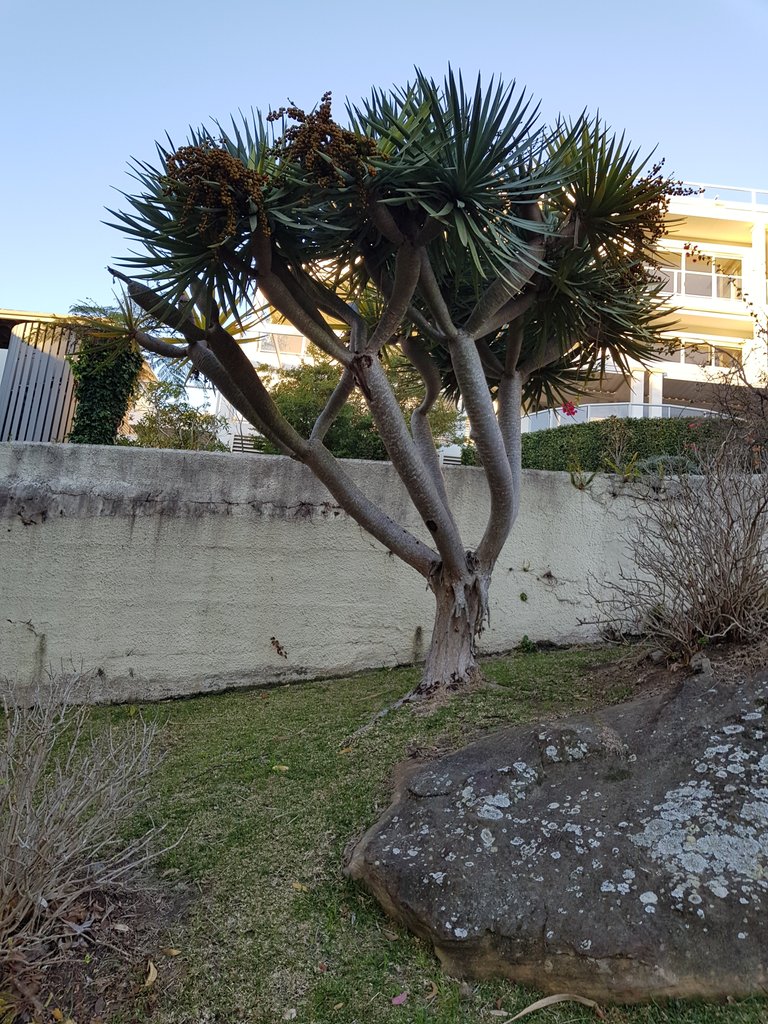
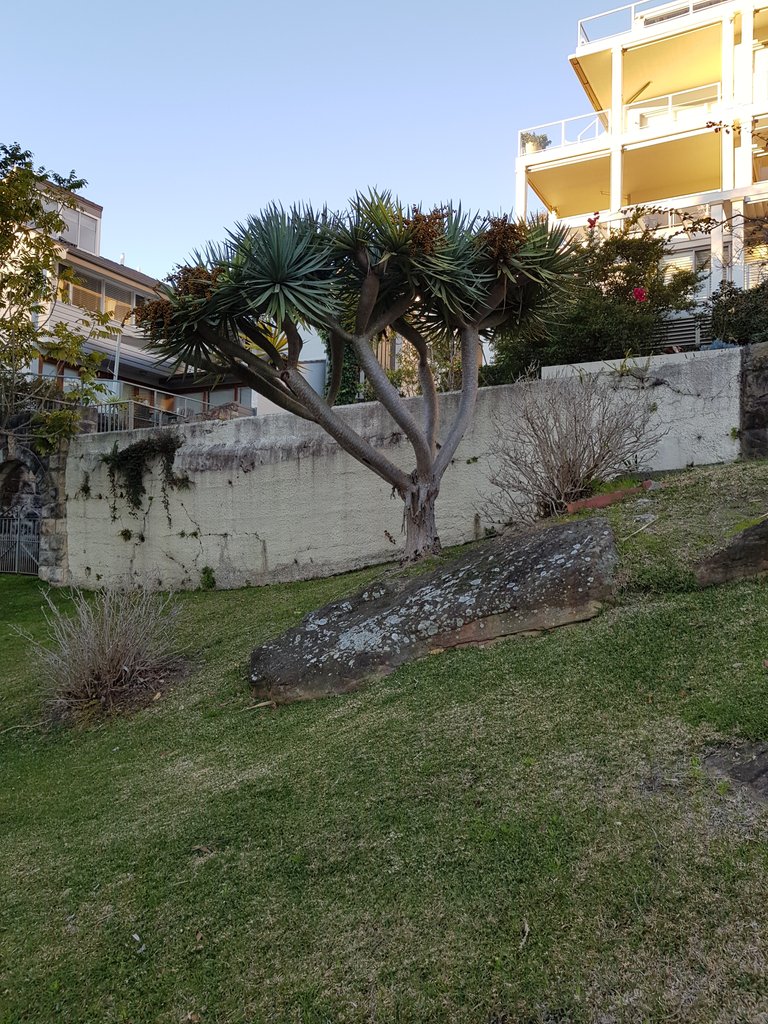
Dragon tree is a palmlike member of the agave family, related to Spanish bayonet (Yucca aloifolia), and century plant (Agave americana). The overall shape is that of an umbrella with a thick, swollen trunk and many stout, upright branches each terminating with a rosette of stiff, sword shaped leaves about 2 ft (60 cm) long.
Mature plants produce terminal clusters of greenish flowers, followed by round reddish orange fruits. In cultivation dragon tree barely gets 20-30 ft (6-9 m) tall, but in its native habitat 50 ft (15 m) tall specimens are not uncommon.
Dracaena draco is native to the Canary Islands, an archipelago of seven volcanic islands in the Atlantic Ocean about 160 miles (100 km) off the northwest coast of Africa. In its native habitat, dragon tree is an endangered species (listed as "Vulnerable") due to over collecting for its red colored resin, called "dragon's blood".
Dragon tree is grown as an ornamental throughout the world in Mediterranean climates, and is very popular in southern California.
Source
Silly Sausage Award !! You selected great Pics and nice information. Thanks.
Dracaena draco , also known as the “Dragon Tree”, or “Dragon's Blood Tree” is a drought-tolerant tree-like plant that can grow to become an stunning garden specimen or indoor plan. Native to the Canary Islands, Cape Verde, and Madeira, Dracaena draco grows a ringed succulent trunk topped by clustered flexible sword-like blue-green leaves. Generally unbranched until it flowers, Dracaena draco then produces branches from the sides of its inflorescence. The leaf scars on its trunk resemble a reptile’s skin, and when cut, the tree ‘bleeds’ a deep red sap known as ‘Dragons Blood’, which can be used to stain wood.
Dracaena draco , the symbol of the island of Tenerife, grows well in full sun or part shade, and needs good drainage. It adapts well to container growing, and is hardy down to the low 20s or high teens Fahrenheit. Hardy and drought tolerant, Dracaena draco can adapt well to extreme heat, winds and ocean salty weather.
http://www.cycadpalm.com/dracaena-draco-plants.html
The Dragon tree is often planted as a special interest feature plant in ornamental landscapes and gardens in many parts of the Inland Empire. Over time it will grow into a medium size tree with a stout succulent trunk up to 25 ft. tall.
As plants mature, they develop broad crowns comprised of many branches extending outward to form a bold canopy shape. Gray-green foliage is comprised of 2 ft. long sword-shaped leaves; creamy-white flowers occur in large spikes above the foliage and are followed by bright orange berries.
Native to Mediterranean climates on the Canary Islands, the dragon tree is one of the most unusual plants for ornamental landscapes. It is highly adapted to warm and sunny climate exposures and easily adapts to annual summer drought.
It shows sensitivity to cold temperatures below 25°F and should be planted in warm microclimate areas. Young plants are often grown in containers and raised planters to display their character as their trunks mature.
Like other succulent-type plants, the dragon tree grows best in well-drained soils with infrequent summer watering. It takes many years to achieve tall and large specimen stature, but it is well worth the effort as few plants provide such unique character.
Resources
The dragon's blood plant (Dracaena draco) is not the friendliest or most beautiful of houseplants. But it has the single most important quality for your indoors foliage—it is tough beyond all measure. It has somewhat severe, stiffly pointed leaves that end in something resembling a spike. The leaves are solidly green, and the plant will grow to a height of 3 or 4 feet indoors.
The dragon's blood name comes from the fact that it exudes reddish resin from wounds and nicks. As a point of interest, it is said that this resin was used as a wood dye to stain the famous Stradivarius violins. It is a member of the agave family and is related to the yucca and century plant.
Native to the Canary Islands, these plants appreciate excellent drainage—the quickest way to kill it is to waterlog the roots. Watch out for leaf-tip browning, which can be corrected by using non-fluoridated water.
Source: https://www.thespruce.com/grow-dracaena-draco-1902753
The Dragon tree is often planted as a special interest feature plant in ornamental landscapes and gardens in many parts of the Inland Empire. Over time it will grow into a medium size tree with a stout succulent trunk up to 25 ft. tall. As plants mature, they develop broad crowns comprised of many branches extending outward to form a bold canopy shape.
Gray-green foliage is comprised of 2 ft. long sword-shaped leaves; creamy-white flowers occur in large spikes above the foliage and are followed by bright orange berries.
Native to Mediterranean climates on the Canary Islands, the dragon tree is one of the most unusual plants for ornamental landscapes. It is highly adapted to warm and sunny climate exposures and easily adapts to annual summer drought

. It shows sensitivity to cold temperatures below 25°F and should be planted in warm microclimate areas. Young plants are often grown in containers and raised planters to display their character as their trunks mature.
Source
Lovely Pics !
Dracaena draco is a woody, evergreen tree monocot that can grow to about 10-15 m in height (but exceptionally up to 21 m tall and up to 15 m in circumference at the base of the trunk). Both trunk and branches produce large, compact clusters of silvery gray leaves.

Silvery-grey, smooth dichotomously branched. When young the stem is single. At about 10-15 years of age the stem stops growing and produces a flower spike. Soon a crown of terminal buds appears and the plant starts branching.
Generally has a large central trunk that with age may develop a number of side branches subtending a hugely wide semiglobose umbrella-shaped canopy. Not to be confused with Dracaena cinnabari, the Dragon Blood Tree native to Socotra.
Each branch grows for about 10–15 years and re-branches, so to determine its age one has to know roughly how often they flower, once every ten to 15 years (maybe more frequently in the Azores), and count the number of branches, so the age of the tree can only be estimated by the number of branching points before reaching the canopy.

http://www.llifle.com/Encyclopedia/SUCCULENTS/Family/Dracaenaceae/22863/Dracaena_draco
Oh, yes, a beautiful plant @ctrl-alt-nwo and Dracaena draco (Dragon Tree) - An attractive and an interesting succulent tree that is commonly used as a house plant, but if planted in the ground in our near frost free climate it will grow to a massive and broad tree that is 25 feet tall and as wide and, with great age, even larger - one of the tallest ever recorded was over 70 feet tall. The terminal ends of the thick branches hold clusters of 2 foot long by 1 1/2 inch wide pliable sword-shaped blue-green leaves. In early summer appear the greenish-white flowers that are followed by orange berries. This plant remains unbranched until it flowers or is otherwise damaged and then produces two large heavy branches on either side of the inflorescence. When the bark is cut or bruised the sap flows as a reddish colored resin. This resin , one of the sources of a substance known as Dragon's blood can be used to stain wood. Plant in full sun or part shade. Water infrequently and deeply - do not allow the root zone to remain wet as this is the easiest way to kill this plant. It is hardy to about 20-25 degrees F - our tree in front of the nursery had foliage damaged but no lasting damage our in our 1990 freeze at 18 °F.
A very hardy and drought tolerant tree that tolerates extreme heat, winds and salt spray. This plant is native to the Canary Islands, Cape Verde, Madeira, and western Morocco and is the natural symbol of the island of Tenerife, the largest of the Canary Islands. It is on Tenerife where one can find the "Drago Milenario" (Thousand Year old Draco), a famous giant dragon tree located in Parque del Drago in Northern Tenerife that is believed by many people to be over a thousand years old, but others estimate it to be in the hundreds. Since monocots such at this do not form growth rings, the actual age of the plant is unknown, though the tree was declared a national monument in 1917. This species is on the International Union for Conservation of Nature (IUCN) List of Threatened Species Red List as Vulnerable (A1a-e) meaning that it is facing a high risk of extinction in the wild in the medium-term future for numerous reasons (loss of habitat, exploitation, competition etc). The name Dracaena comes from the Latin word 'draco', meaning "dragon" that was already used for the specific epithet for this same plant. This new name was ascribed by Linnaeus in 1767 when he renamed the plant originally called Asparagus draco. This species received the coveted Royal Horticultural Society's Award of Garden Merit (AGM) in 2002.
We have been growing this plant since 1982 and have a 30 year old specimen along the street at our nursery entrance. Though not included on most posionous plant lists, some references claim that seed of the Dracaena draco is posionous, while others such as on the California Poison Control System, list it as safe plant. Since this contradictory information exists, we err on the side of caution, and list it as poisonous, though we cannot verify the validity of this or what the posionous active ingredient would be. This description is based on our research and observations made of this plant as it grows in our nursery, in the nursery garden and in other gardens that we have visited.
https://www.smgrowers.com/products/plants/plantdisplay.asp?plant_id=530
This tree is interested in that, he has a red juice. The name of this beautiful tree is of mythical origin: for his 11th work, Hercules was to return three golden apples from the garden of Hesperida, which is guarded by Landon, hundreds of dragons. Hercules killed Landon, and his blood flowed over the ground, which began to sprout the trees of the "dragon". The tree exudes "dragon blood" - red juice - at the cut.
Chests long and slender, and leaves prickly. The flowers are greenish white and have a sweet smell. Orange-brown berries are slightly less than cherries, pointed and covered with red, resinous substance and pleasant to taste. The tree is always green and durable. Thanks for the interesting posts.
https://translate.google.ru/translate?hl=ru&sl=en&u=https://www.arkive.org/dragon-tree/dracaena-draco/&prev=search
https://diacos.com.au/product/draceana-draco-dragon-tree/
The dragon's blood plant (Dracaena draco) is not the friendliest or most beautiful of houseplants. But it has the single most important quality for your indoors foliage—it is tough beyond all measure.
It has somewhat severe, stiffly pointed leaves that end in something resembling a spike. The leaves are solidly green, and the plant will grow to a height of 3 or 4 feet indoors.
The dragon's blood name comes from the fact that it exudes reddish resin from wounds and nicks.
As a point of interest, it is said that this resin was used as a wood dye to stain the famous Stradivarius violins. It is a member of the agave family and is related to the yucca and century plant.
Souce
I think this plant ins growing at dry zone area and near to ocean! Coz I have see little bit similar type of plant at coastal area of my country!
Anyway it seems nice and you made a wonderful photography as well! Thank you!@ctrl-alt-nwo,
Cheers~
This tree was discovered by Professor Issac Bayley Balfour in 1880. This tree is shaped like an umbrella with leaves growing on its tops. However, the form is difficult to work for the life of this tree. The added leaves can reduce the filling process and help this tree to survive in areas where the temperature is very hot
This dragon blood tree grows in dry areas and can reach more than 300 years. This Socotra dragon blood tree is still brothers with Dracaena draco from the Canary Islands, Spain. In its place of origin, Dracaena draco or also called the dragon blood tree is also one of the trees called the blood tree because this tree is red. This sap is called dragon blood. Dragon's blood is very useful for medicines, dyes, sweeteners and fragrances. In addition, for local people today in concrete as toothpaste, bath soap, glue, and coloring materials. Getalh can also be used as a digestive medicine, diarrhea, fever, respiratory problems, and sore throat.
The Dragon Tree ranks among the most interesting and eye-catching plants. In cooler and medium warm climates these are popular like houseplants only.
The leathery, sword-shaped leaves are green. Grows very slowly and in 10 years reaches 1 m.
Dragon Tree is insensible against heat and air dryness. For this reason is perfect for central-heated rooms and winter gardens.
This species has an exceptional Longevity. There was in the garden of the maison Franchi in La Orotava in Tenerife a 5000 years old dragon tree which was destroyed by a hurricane in 1868. The age of this tree is today estimated at 600 years only. In 1996, a small wild population was rediscovered in the Moroccan High Atlas, near Agadir (Dracaena draco subsp. ajgal).
dragon tree does best in a bright spot, but will tolerate low-light conditions so you can grow it practically anywhere. In such low-light spots, you may see it lose the red or pink coloring on leaf edges and it will grow more slowly (and also require less water).
https://www.google.co.uk/url?sa=t&source=web&rct=j&url=https://www.smgrowers.com/products/plants/plantdisplay.asp%3Fplant_id%3D530&ved=2ahUKEwjGo6Dx-7XdAhVJDMAKHSPhBMMQFjAjegQIBBAB&usg=AOvVaw1jRDOnK48J5mhho80fL80H
As the common name suggests, this tree fits at home with the movie set of Dracula, or possibly Jurassic Park. The very distinctive flat topped and regularly arranged swollen branches of this tree make it a strikingly different specimen.
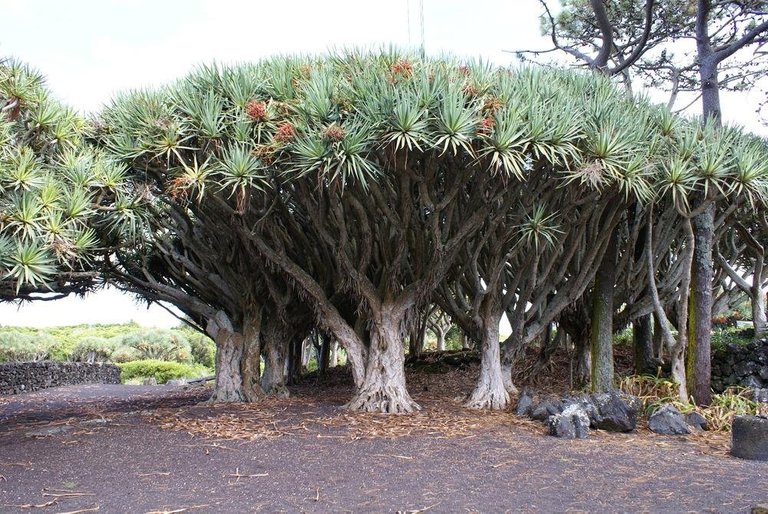
Dracaena draco is subtropical, but can grow well in a tub because of its slow growth. After 10 years the plant is approximately 100 cm high.
This tree has no annual rings and the age of the dragon blood tree can only be estimated based on the number of branches.
Every 10 to 15 years, the growth of the stem stops and a flower stem with white lily-like aromatic flowers appears.
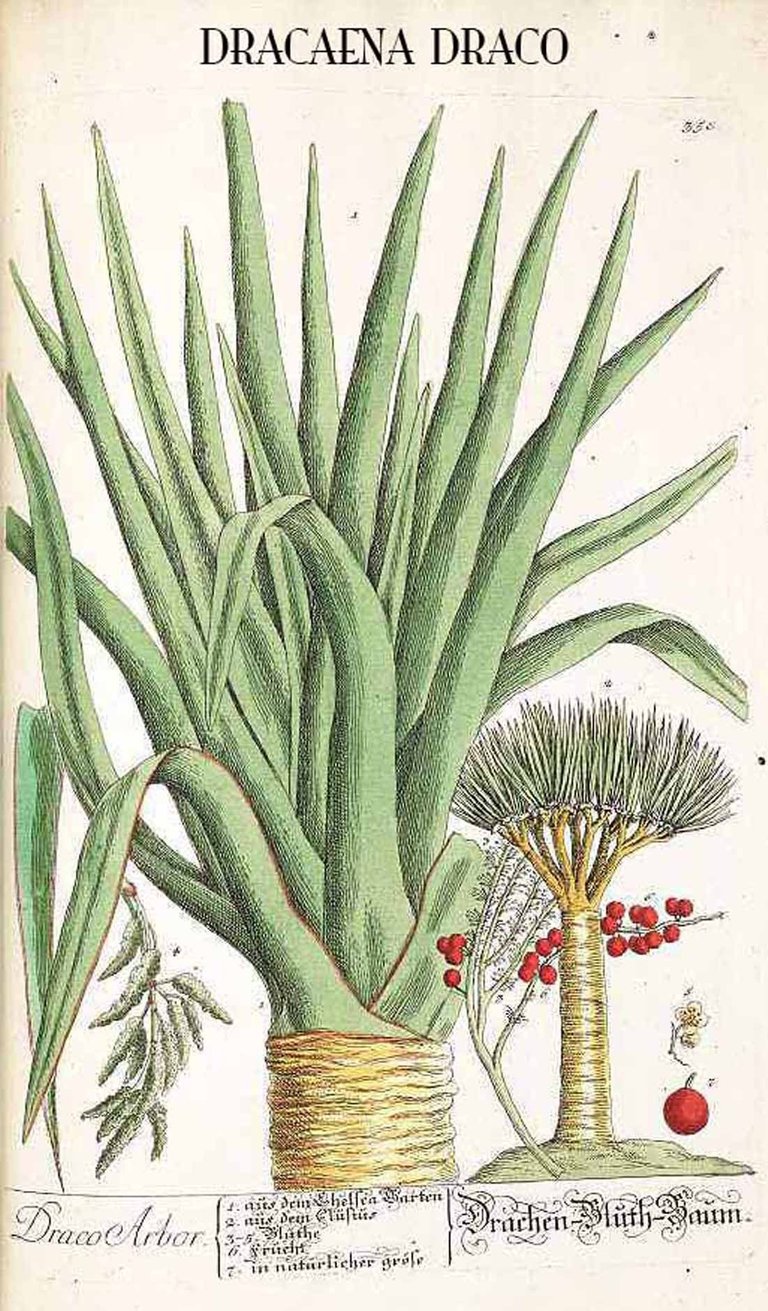
After flowering, the plant branches and grows on the branches again. These branches branch again after 10 to 15 years.
Source
Shared on twitter promoting good quality content on #Steemit. Stephen
#Promo-Steem #steemtalent #JoinSteemit #Steemit
Dragon Tree. #steemtalent #JoinSteemit #Steemit @Steemit
#gardening #blog #blogger #dracaena #plants #garden #australia
Here is an old one in the Canary Islands.....
Ancient Dragon Tree
In Icod, close to the Church of San Marcos, stands a famous dragon tree (22 m high, lower trunk diameter 10 m, estimated weight 70 t), which is reputed to be a thousand years old (hence its local name, El Drago Milenario: the Thousand-Year-Old Dragon). While no study seems to have confirmed such longevity for the tree (dracos do not produce annual rings with which to tell their ages; the tree is more likely to have an age in the hundreds of years[3]), it is the long-time symbol of Icod.
Taken from ... wikipedia
Dracaena marginata is an attractive, stiff-leaved plant with colorful foliage that sometimes goes by the name dragon tree. Most of the time, though, it’s sold simply as “Dracaena marginata” or just “Dracaena.” These plants are perfect for a beginner gardener because they're very easy to grow indoors.
These are tough, drought-tolerant plants with aggressive root systems that make excellent houseplants because they are a little more forgiving than some of the other dracaena. It helps that they’re attractive and varied. They are sometimes grown as single-stemmed plants; other times grouped or even braided together in the same pot.
https://www.thespruce.com/grow-dracaena-marginata-indoors-1902749
The Dragon Tree ranks among the most interesting and eye-catching plants. In cooler and medium warm climates these are popular like houseplants only.
The leathery, sword-shaped leaves are green. Grows very slowly and in 10 years reaches 1 m.
Dragon Tree is insensible against heat and air dryness. For this reason is perfect for central-heated rooms and winter gardens.
Source
If growing conditions are too hot or too dry, brown leaf points appear.
Source
There is very interesting variety of Dragon tree named "dragon’s blood" in ancient times due to its peculiar red sap, this tropical succulent tree is most unusual. It is native to just a small area on the Canary Islands off the west coast of Africa.
In habitat they grow to a great age.
Source
Dragon’s Blood Trees produce an uncanny facsimile of mammalian blood when cut. A clever coincidence of nature, the sap is also extremely compatible with mammal bio-systems. For many thousands of years, experienced indigenous healers in South America have known about the powerful medicinal properties of this sap.
Source
Dragon’s Blood is viscous, deep red, and has an earthy aroma.
Text Source
dragon tree, also called red-edge dracaena, is one of the most popular houseplants around. It bears narrow green leaves banded in red or pink on top of slender stems. Its upright habit makes Madagascar dragon tree a useful houseplant to grow against a blank wall, to provide privacy in front of a window, or at the end of a sofa or chair as it ages and becomes tree like. When it's young, Madagascar dragon tree adds beautiful texture to tabletops, desks, and other surfaces. It's often included in dish gardens because of its grassy look.
dragon tree does best in a bright spot, but will tolerate low-light conditions so you can grow it practically anywhere. In such low-light spots, you may see it lose the red or pink coloring on leaf edges and it will grow more slowly (and also require less water).
http://www.costafarms.com/plants/madagascar-dragon-tree
Spreading the wings branches like a dragon there wonderful to know about this plant
As the common name suggests, this tree fits at home with the movie set of Dracula, or possibly Jurassic Park. The very distinctive flat topped and regularly arranged swollen branches of this tree make it a strikingly different specimen.

This tree was discovered by Professor Issac Bayley Balfour in 1880. This tree is shaped like an umbrella with leaves growing on its tops. However, the form is difficult to work for the life of this tree. The added leaves can reduce the filling process and help this tree to survive in areas where the temperature is very hot
This dragon blood tree grows in dry areas and can reach more than 300 years. This Socotra dragon blood tree is still brothers with Dracaena draco from the Canary Islands, Spain. In its place of origin, Dracaena draco or also called the dragon blood tree is also one of the trees called the blood tree because this tree is red. This sap is called dragon blood. Dragon's blood is very useful for medicines, dyes, sweeteners and fragrances. In addition, for local people today in concrete as toothpaste, bath soap, glue, and coloring materials. Getalh can also be used as a digestive medicine, diarrhea, fever, respiratory problems, and sore throat.
The Dragon Tree ranks among the most interesting and eye-catching plants. In cooler and medium warm climates these are popular like houseplants only.
The leathery, sword-shaped leaves are green. Grows very slowly and in 10 years reaches 1 m.
Dragon Tree is insensible against heat and air dryness. For this reason is perfect for central-heated rooms and winter gardens.
This species has an exceptional Longevity. There was in the garden of the maison Franchi in La Orotava in Tenerife a 5000 years old dragon tree which was destroyed by a hurricane in 1868. The age of this tree is today estimated at 600 years only. In 1996, a small wild population was rediscovered in the Moroccan High Atlas, near Agadir (Dracaena draco subsp. ajgal).
dragon tree does best in a bright spot, but will tolerate low-light conditions so you can grow it practically anywhere. In such low-light spots, you may see it lose the red or pink coloring on leaf edges and it will grow more slowly (and also require less water).
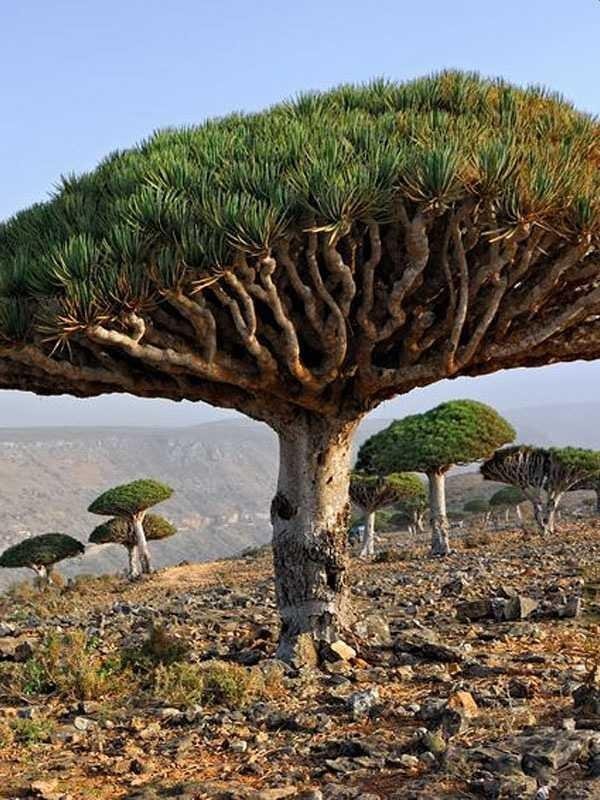
https://www.google.co.uk/url?sa=t&source=web&rct=j&url=https://www.smgrowers.com/products/plants/plantdisplay.asp%3Fplant_id%3D530&ved=2ahUKEwjGo6Dx-7XdAhVJDMAKHSPhBMMQFjAjegQIBBAB&usg=AOvVaw1jRDOnK48J5mhho80fL80H
Flowering and seeds
This species flowers during January to July [1,2,4,5]. The fruits usually produce two seeds per follicle which are often released spontaneously, usually within a year after maturation. There are about 40 viable seeds per gram; seeds start to germinate in about 7 days if grown at 25°C and no pretreatment is required
Cultivation and uses
Banksia integrifolia is a fast-growing tree suitable for coastal plantings where resistance to wind and salt exposure is important [2]. It prefers sandy acidic soils and is moderately drought and frost tolerant. The heartwood.

integrifolia is pinkish to red, useful for ornamental turnery and is occasionally used for cabinetwork and in panellings where a red-hued, ray-blazoned timber is required. It is an important species to apiculture for its pollen and for the dark amber coloured honey which is of medium value.Nectivorous birds will be attracted to the species when it is flower
Source
This tree has lots of sharp claws just like the dragon. This one just had some flowers but I couldn't tell about the colour of these flowers.
Very interesting shape, the stems look like long arms!
The flowers looked to me to be a sort of dirty creamy white colour.
Dragon Tree comes from the Socotra Islands. Also called the Dragon Blood Tree and the Socotra Dragon Tree. This tree is one of the strangest trees in the Socotra archipelago, with an umbrella-like shape. This plant is also known as Suji Socotra and Dragon Blood Tree.

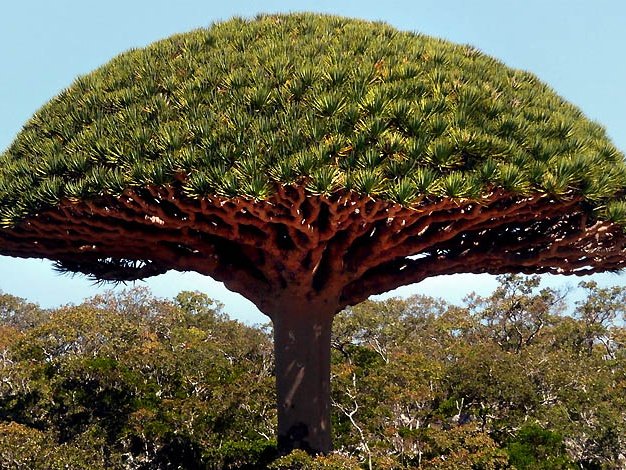
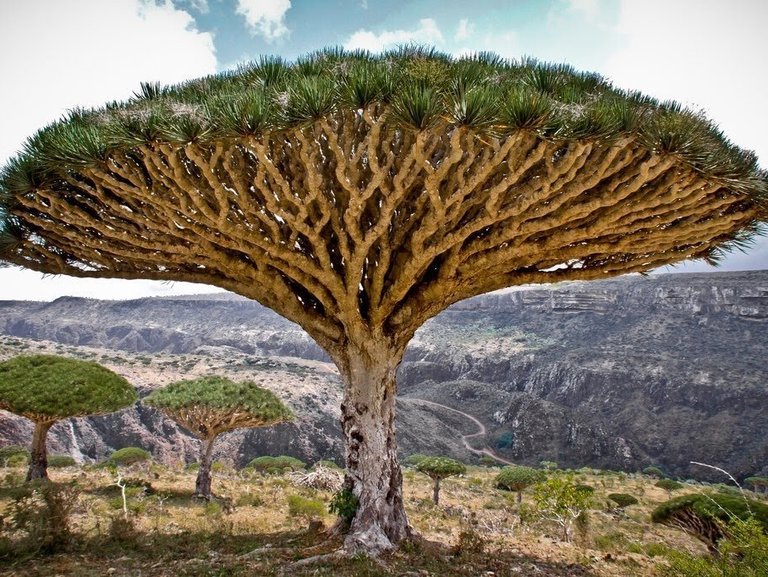

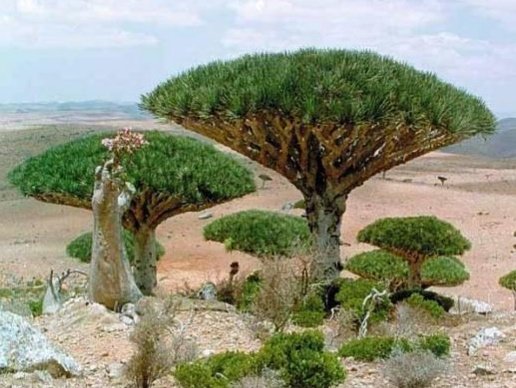
This flora is called so because of the red sap produced by this plant.
First published by Isaac Bayley Balfour, in 1882. When noted, this tree was once an icon in Windows as a Network icon. Dragon's blood is taken from the color of the red sap, and can be used as medicine or dye dye.
Dragon trees are remnants of sub-tropical forests that died millions of years ago in the Pliocene era. This tree looks like a combination of mushrooms, umbrellas, and cranial tissue, which is strange. Trees have long been valued for thousands of years for their bright red resin. This resin is produced when the tree is pierced. Because the resin that comes out is red, this tree is also known as the dragon blood tree.
For thousands of years, this dragon's blood has been used as traditional medicine, ingredients in alchemy for ritual and magic, and red coloring. This resin has also been used for violin varnishes, as toothpaste, as an adhesive, as a medicine for diarrhea, in photoengraving, incense, to treat post-partum hemorrhage, and as body oil.
Dragon trees are monocots: they do not have xylem and phloem like most trees or branches that extend from the trunk; everything grows from the very top, like a palm tree. The long, thin and stiff leaves that they produce, only grow from the tip of the youngest branches and last for three to four years. The stem and branches are thick, when the buds at the ends of the branches stop growing, the branches will divide into two, creating a density, patterns of surreal branches.
This pattern is a very functional appearance, to create a dense and shady branching, in Socotra which is hot and dry, It is intended to protect the soil around the tree and to reduce evaporation from the soil, thus providing optimal living conditions for each seed in underneath it. Small fruits are produced, generally eaten by birds, which then spread the seeds to other places.
Source:
https://www.google.co.id/url?sa=t&source=web&rct=j&url=http://smart-pustaka.blogspot.com/2011/02/dracaena-cinnabari-pohon-darah-naga.html%3Fm%3D1&ved=2ahUKEwjJireC5bXdAhWMqo8KHYtcBzgQFjAKegQIABAB&usg=AOvVaw3UdBxn5lxGxkFd-WcAjUN1
Beautiful Pics !
In western cultures, the deep-red resin dragon's blood has been an exotic ingredient of traditional medicines and dyes since ancient times. The resin, a dried exudate, is extracted from different species in different parts of the world; sources include members of the Euphorbiaceae, Fabaceae and Arecaceae. However, the most famous sources are two Dracaena species: Socotran dragon's blood (Dracaena cinnabari) and Canary Island dragon's blood (Dracaena draco).
Dracaena draco, whose scientific name reinforces its association with dragons, is a combination of the Greek 'she-dragon' and 'dragon'. It is native to Macaronesia (Madeira, Canary Islands, Cape Verde) and Morocco, where natural populations are frequently small, and under threat from humans hence the dragon tree is considered Vulnerable. However, the dragon tree is very widely cultivated for its form, curiosity and symbolic value. The first reports of dragon trees in the Canary Islands came from Jean de Bethencourt's expedition in 1402.
The genus Dracaena contains about 120 species. Most species are found in wet and dry forests of the Old World tropics, with outliers in Micronesia and Macaronesia, the Caribbean and Central America. The discovery of a 16 million-year-old fossil Dracaena from Anatolia, with features allied to the xerophyte Dracaena draco, has been used to suggest modern dragon trees may have evolved from wet-forest species.
The dragon tree has a very distinctive growth form. Young trees have single stems and are topped by a dense crown of long, sword-shaped leaves. After about a decade, the first white, lily-like flowers and red fruits are produced. A crown of terminal buds is formed and the plant starts to branch. The branches grow for about another decade, flower and branch again. Repetition of the process over time produces a tree with a hemispherical crown. Branches also produce aerial roots which grow down to the soil, contributing to the bulk of old trees.
Individual dragon trees live to immense ages. When the Prussian naturalist and biogeographer Alexander von Humboldt visited Tenerife in 1799, on his way to South America, he saw a dragon tree at Oratava which he measured as over 21 metres tall and nearly five metres in diameter. The tree was venerated by the Guanche and Humboldt estimated its age as about 6,000 years old; the plant was lost in a storm in 1868. Today, the oldest living specimen on the island is at Icod, although it is probably only about 400 years old.
Source
Dracaena draco, the Canary Islands dragon tree or drago, is a subtropical tree-like plant in the genus Dracaena, native to the Canary Islands, Cape Verde, Madeira, and locally in western Morocco, and introduced to the Azores. It is the natural symbol of the island of Tenerife, together with the blue chaffinch.
Dracaena draco is a monocot with a tree-like growth habit currently placed in the asparagus family (Asparagaceae, subfamily Nolinoidae). When young it has a single stem. At about 10–15 years of age the stem stops growing and produces a first flower spike with white, lily-like perfumed flowers, followed by coral berries.
Soon a crown of terminal buds appears and the plant starts branching. Each branch grows for about 10–15 years and re-branches, so a mature plant has an umbrella-like habit. It grows slowly, requiring about ten years to reach 1.2 metres (4 ft) in height but can grow much faster.
The specimen called "El Drago Milenario" (the thousand-year-old dragon) growing at Icod de los Vinos in northwest Tenerife is the oldest living plant of this species. Its age was estimated in 1975 to be around 250 years, with a maximum of 365 years, not several thousand as had previously been claimed.
Souce
The Dracaena draco tree is characterised by a single or multiple trunk growing up to 12 metres (39 ft) tall (rarely more), with a dense umbrella-shaped canopy of thick leaves.
It grows slowly, requiring about ten years to reach 1 metre (3 ft 3 in) tall. Young trees remain with only a single stem; branching occurs when the tree flowers, when two side shoots at the base of the flower panicle continue the growth as a fork in the stem.
Being monocotyledonous, Dracaena draco does not display annual rings and age can only be estimated by the number of branch forking occurrences (indicating the number of flowering episodes) and measuring the frequency of flowering (less than annual).
Some specimens are believed to be up to 600 years old; the oldest is growing at Icod de los Vinos in northwest Tenerife.
Dracaena draco is winter hardy outdoors. It will survive temperatures as low as 22 degrees F.
It can take high heat but performs best when protected from very strong afternoon sun. In very bright desert locations, part sun would be the preferred exposure.
Mature trees are insect and fire resistant but should be protected from high winds.
Source
As always unusual for my country. I do not cease to wonder what kind of plants there are on our planet. The slowly growing, award-winning Dracaena dragon (the Tree of Dragons) is an evergreen tree with attractive hefty limbs and stiff but flexible leaves. A weakly branched, thick, swollen, cylindrical chest empties into thick, upright arms with sword-shaped rosettes, blue-green leaves up to 2 feet long (60 cm) long. Originally smooth and gray, the bark becomes scaly with horizontal red strips, a reminder that this tree is bleeding crimson juice when the bark is cut or bruised. Draped into the blood of dragons, (Drakena means the dragon of ancient Greek), this juice is used as a varnish for violin and other small wood. This very decorative tree does not begin to branch until it first blossoms, as a rule, after several decades of growth. The dragon tree is very long, and some specimens on the Canary Islands say they are more than a thousand years old.The dragon tree is very long, and some specimens on the Canary Islands say they are more than a thousand years old.
https://translate.google.ru/translate?hl=ru&sl=en&u=https://www.gardenia.net/plant/Dracaena-draco-Dragon-Tree&prev=search
The wild subpopulations of the dragon tree have been in decline for a long time. The species is present in five of the seven islands in the Canaries and the total population is reduced to a few hundred trees.
In Madeira and Porto Santo, it was once an important component of the vegetation in more arid areas but is reduced today to two individuals in the wild.
A survey in 1996 revealed new subpopulations in North Africa, in the Anezi region of the Anti-Atlas Mts. in Morocco.
Thousands of individuals exist on steep quartzite cliffs in inaccessible gorges.
These subpopulations are likely to represent a distinct variant of the species. Its closest relative is the dragon tree endemic to Socotra.
Source
The Canary Islands dragon tree, like its close relative, the Socotra dragon tree, is a member of the asparagus family. It is well known for its striking umbrella like appearance and has long been used and valued by people living within its natural range and by those living further afield in the Mediterranean.
The Guanche people of the Canary Islands used the sap in their mummification processes. In Ancient Rome, ‘sangre de drago’ was used as a colorant. Across Europe it has been used as a varnish and anti-oxidant for iron tools.
The tree also played a role in the Greek myth: “The Eleventh Labour of Hercules: The Apples of the Hespérides”.
After Landon, a hundred-headed dragon, is slain, red blood flowed out upon the land and from it sprung up the trees that we now know as ‘dragon trees’.https://www.gardenia.net/rendition.slider_detail/uploads/plant/1488133888-85e149332afb5e337/Dragon%20tree%20(Dracaena%20draco)2.jpg
The tree once played an important ecological role. Approximately five hundred years ago the fruit of the dragon tree was the staple food of an endemic, Dodo-like, flightless bird that is now extinct.
source
The Dracaena marginata is a species from a large plant genus (Dracaena) that has many variations in leaf sizes, leaf colors and different trunk types. The marginata is one of the most popular seen indoors that grows into an attractive plant and becomes a great focal point of a room, once it has matured enough.
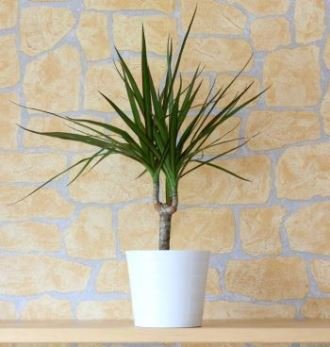

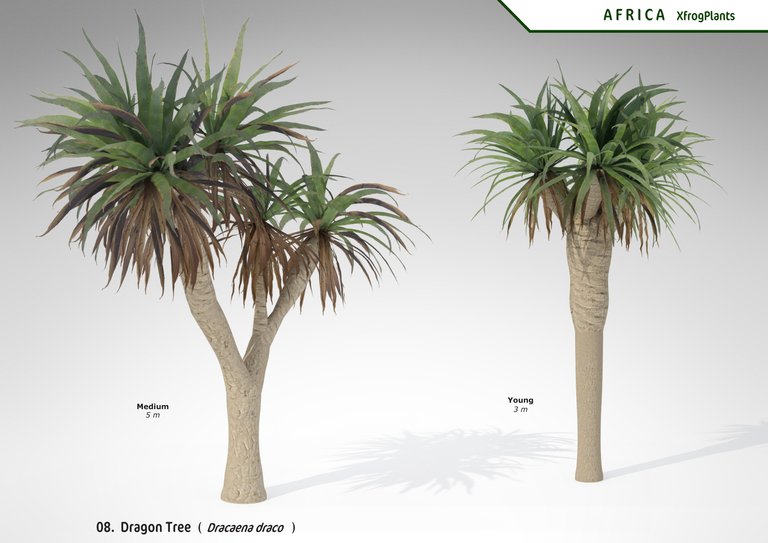 https://www.houseplantsexpert.com/madagascar-dragon-tree.html
https://www.houseplantsexpert.com/madagascar-dragon-tree.html
How it looks and grows: The leaves are quite slim compared to other Dracaena's with arching leaves. There are three types, one has a dark red outer edge leaves with a green center, another is green in the center with red and yellowish stripes and the other the colorama has thick red edges. The leaves are produced when the trunk grows stems (cane) from the side that often needs to be trained (keeps them growing upwards). These stems have a grayish brown bark (the trunk) that can also produce smaller ones, so the Dragon tree really needs to be pruned to avoid the plant from growing in all directions
These are slow grower's that can take about 10 years to reach over 5ft tall but look lush once they reach about a foot high. They have a very similar look like palm tree plants.
Level of care: The Madagascar dragon tree is one of the easiest house plants to grow and takes neglect on the chin - then recovers quickly once the correct conditions and care is provided. The one I gave to my sister (about 5ft in height) over 10 years ago was neglected more than cared for and is now looking great.
Leaves falling: If leaves start dying and coming away at the bottom of the plant - do not worry. This is natural and similar to how a yucca tree sheds its bottom leaves for new growth. You can remove them once you see them deteriorating in appearance.
Dracaena draco: The dragon tree
In its natural habitat in the Canary Isles, the dragon tree, or Dracaena draco, is now almost extinct. Humans coveted the blood-red juice that seeps out from cuts made in its bark. This bitter-tasting juice is actually a resin that hardens quickly after exposure to air. It’s known as dragon’s blood thanks to its deep red color and sanguine consistency.
Dragon’s blood has been used since ancient times. The aboriginal inhabitants of the Canary Isles used it to mummify their dead. Dragon’s blood is also used in traditional medicine: It was taken internally to treat diarrhea, and is also used externally to heal wounds. It was also taken to prevent scurvy, a disease caused by a lack of Vitamin C in the diet. Its similarity to human blood also caused it to be used in traditional rituals and magic.
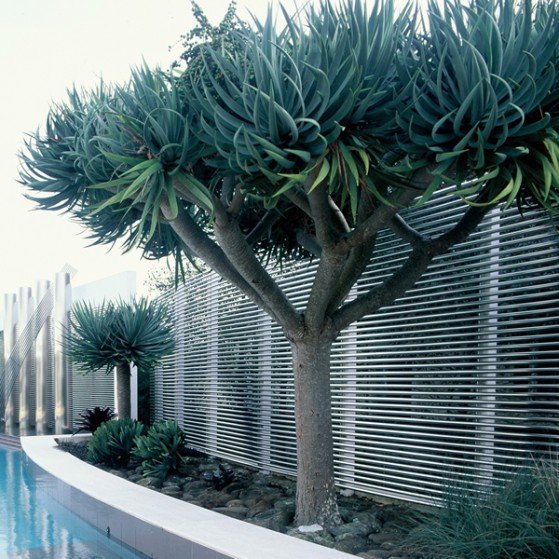
Dried, it was burnt as incense for a spiritually cleansing effect. In the Middle Ages, dragon’s blood was nearly worth its weight in gold. In addition to its medicinal properties, this red resin was used as a varnish for stringed instruments. Today, it still finds use in making paints, varnishes, and polishes for wood and marble.
The tree can reach a height of up to 20 meters. They do not develop growth rings, but older specimens can be recognized by the dense forking of branches in the crown of the tree. The flowers of the dragon tree are white, and arranged in long panicles. When fruiting, it produces berries of an orange-red color.
Content and Images
This tree was discovered by Professor Issac Bayley Balfour in 1880. This tree is shaped like an umbrella with leaves growing on its tops. However, the form is difficult to work for the life of this tree. The added leaves can reduce the filling process and help this tree to survive in areas where the temperature is very hot
This dragon blood tree grows in dry areas and can reach more than 300 years. This Socotra dragon blood tree is still brothers with Dracaena draco from the Canary Islands, Spain. In its place of origin, Dracaena draco or also called the dragon blood tree is also one of the trees called the blood tree because this tree is red. This sap is called dragon blood. Dragon's blood is very useful for medicines, dyes, sweeteners and fragrances. In addition, for local people today in concrete as toothpaste, bath soap, glue, and coloring materials. Getalh can also be used as a digestive medicine, diarrhea, fever, respiratory problems, and sore throat.
The Dragon Tree ranks among the most interesting and eye-catching plants. In cooler and medium warm climates these are popular like houseplants only.
The leathery, sword-shaped leaves are green. Grows very slowly and in 10 years reaches 1 m.
Dragon Tree is insensible against heat and air dryness. For this reason is perfect for central-heated rooms and winter gardens.
This species has an exceptional Longevity. There was in the garden of the maison Franchi in La Orotava in Tenerife a 5000 years old dragon tree which was destroyed by a hurricane in 1868. The age of this tree is today estimated at 600 years only. In 1996, a small wild population was rediscovered in the Moroccan High Atlas, near Agadir (Dracaena draco subsp. ajgal).
dragon tree does best in a bright spot, but will tolerate low-light conditions so you can grow it practically anywhere. In such low-light spots, you may see it lose the red or pink coloring on leaf edges and it will grow more slowly (and also require less water).
https://www.google.co.uk/url?sa=t&source=web&rct=j&url=https://www.smgrowers.com/products/plants/plantdisplay.asp%3Fplant_id%3D530&ved=2ahUKEwjGo6Dx-7XdAhVJDMAKHSPhBMMQFjAjegQIBBAB&usg=AOvVaw1jRDOnK48J5mhho80fL80H
As the common name suggests, this tree fits at home with the movie set of Dracula, or possibly Jurassic Park. The very distinctive flat topped and regularly arranged swollen branches of this tree make it a strikingly different specimen.

The Dragon blood tree or Dracaena Cinnabari is a unique child from the Socotra archipelago, Yemen. This Pohorn does not only have the same appearance as red sap or resin known as dragon blood. This tree also includes trees and the world in the world.
This tree was discovered by Professor Issac Bayley Balfour in 1880. This tree is shaped like an umbrella with leaves growing on its tops. However, the form is difficult to work for the life of this tree. The added leaves can reduce the filling process and help this tree to survive in areas where the temperature is very hot
This dragon blood tree grows in dry areas and can reach more than 300 years. This Socotra dragon blood tree is still brothers with Dracaena draco from the Canary Islands, Spain. In its place of origin, Dracaena draco or also called the dragon blood tree is also one of the trees called the blood tree because this tree is red. This sap is called dragon blood. Dragon's blood is very useful for medicines, dyes, sweeteners and fragrances. In addition, for local people today in concrete as toothpaste, bath soap, glue, and coloring materials. Getalh can also be used as a digestive medicine, diarrhea, fever, respiratory problems, and sore throat.
Source :
https://www.google.co.id/url?sa=t&source=web&rct=j&url=https://www.msn.com/id-id/gayahidup/rumah-dan-taman/unik-pohon-darah-naga-ini-berbentuk-seperti-payung/ar-BBJ1JZJ&ved=2ahUKEwjMldKayLXdAhXERo8KHWOKBGkQFjAAegQIAhAB&usg=AOvVaw30fcLFAQfDop8kjpE2F4op
I like the shape of the branches for some reason.
In my opinion, this tree is very similar to a dragon. And if you still consider the red juice, it immediately becomes clear why he was so called. This is another plant that I saw for the first time thanks to your blog.
The name of this beautiful tree has mythical origins: for his 11th labour, Hercules had to bring back three golden apples from the garden of the Hespérides, which is guarded by Landon, the hundred-headed dragon. Hercules killed Landon and his blood flowed out over the land, which began to sprout ‘dragon’ trees
(2). The tree exudes ‘dragon’s blood’ – a red sap – when cut
(3). The trunks are long and slender and the leaves are prickly
(4). The flowers are greenish-white and have a sweet smell
(5) The orange-brown berries are a little smaller than a cherry, pointed
Source
Dragon tree is really a beautiful plant. It's extremely slow-growing, taking 8-11 years to reach just 2-3 feet, when it begins to flower. Flowering occurs almost simultaneously on the Canary Islands, taking place only every 15 years.

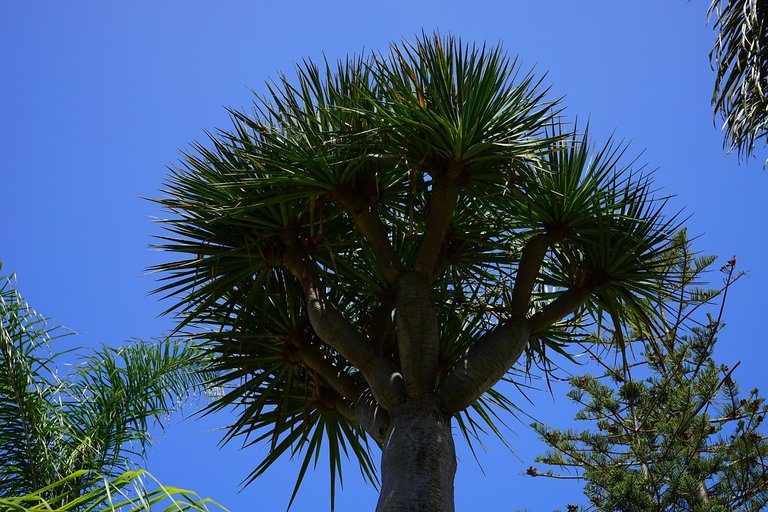
Source
The flowering causes the stem to branch, resulting in a highly branched tree which can be aged according to the number of branches. The oldest individual is thought to be more than 650 years old. The sap of this species is used as colouring matter for varnishes, tooth-pastes, tinctures and plasters.
Source
Source
The dragon tree is found in dry forests. On Madeira and in the Azores, the plant grows in steep coastal cliffs usually below 200 m altitude. In the Canaries, it can be found in inaccessible cliffs from 100 - 600 m altitude, and in Morocco and Cabo Verde it grows high in the mountains.
Source
Dracaena draco (Dragon Tree) - An attractive and an interesting succulent tree that is commonly used as a house plant, but if planted in the ground in our near frost free climate it will grow to a massive and broad tree that is 25 feet tall and as wide and, with great age, even larger - one of the tallest ever recorded was over 70 feet tall.
The terminal ends of the thick branches hold clusters of 2 foot long by 1 1/2 inch wide pliable sword-shaped blue-green leaves. In early summer appear the greenish-white flowers that are followed by orange berries. This plant remains unbranched until it flowers or is otherwise damaged and then produces two large heavy branches on either side of the inflorescence. When the bark is cut or bruised the sap flows as a reddish colored resin. This resin , one of the sources of a substance known as Dragon's blood can be used to stain wood. Plant in full sun or part shade. Water infrequently and deeply - do not allow the root zone to remain wet as this is the easiest way to kill this plant.
It is hardy to about 20-25 degrees F - our tree in front of the nursery had foliage damaged but no lasting damage our in our 1990 freeze at 18 °F. A very hardy and drought tolerant tree that tolerates extreme heat, winds and salt spray. This plant is native to the Canary Islands, Cape Verde, Madeira, and western Morocco and is the natural symbol of the island of Tenerife, the largest of the Canary Islands
source
DESCRIPTION
A great decorative feature tree with its spiky foliage is a hardy, long living evergreen tree has a crown of stiff rosettes of lance shaped leaves to 60cm long and 5cm wide.
Flowers are followed by orange berries in summer.
Native to the Canary Islands.
Adaptable to a range of soils and conditions but prefers a rich moist soil in a protected sunny position, drought and frost tender.
How To Grow
Although seed can be sown most of the year in Australia seed is generally best sown in spring or autumn, avoid the coldest and hottest months of the year. The optimum germination temperature for germination is around 22-30°C for this species.
Soak overnight overnight in tepid water.
Sow seed just below to surface. Do not bury to deeply.
Cover with seed raising mix to a depth of the seed width. Do not bury the seed to deeply.
Place in a warm shaded or semi shaded position to avoid dying out.
Keep warm & moist, avoid drying out or waterlogging the growing mix.
Germination should occur in 14-28 days @ 22-30°C
source
Madagascar Dragon Tree Plant Features
Madagascar dragon tree, also called red-edge dracaena, is one of the most popular houseplants around. It bears narrow green leaves banded in red or pink on top of slender stems. Its upright habit makes Madagascar dragon tree a useful houseplant to grow against a blank wall, to provide privacy in front of a window, or at the end of a sofa or chair as it ages and becomes tree like. When it's young, Madagascar dragon tree adds beautiful texture to tabletops, desks, and other surfaces. It's often included in dish gardens because of its grassy look.

Madagascar Dragon Tree Growing Instructions
Madagascar dragon tree does best in a bright spot, but will tolerate low-light conditions so you can grow it practically anywhere. In such low-light spots, you may see it lose the red or pink coloring on leaf edges and it will grow more slowly (and also require less water).
Water Madagascar dragon tree when the top inch or so of the soil starts to dry. The plant holds up to dry conditions fairly well, so you don't have to worry about it dying if you miss a watering or two.
If your Madagascar dragon tree develops brown leaf tips, the most common cause is low humidity. Add more moisture to the air by grouping it near other houseplants, moving it to a humid room such as bathroom, or setting your Madagascar dragon tree on a large tray filled with pebbles and water (so the bottom of the pot is on the pebbles, above the water line).

Fertilize Madagascar dragon tree once or twice a year at minimum with a houseplant fertilizer. If you want your plant to grow faster, you can feed it more frequently. Just don't exceed the recommendations on the fertilizer package.
If you wish to prune your Madagascar dragon tree, you can cut the top off; it will sprout new branches. If you pot the part you cut off in moist potting mix, it may root and grow into another plant.
This wonderful houseplant is not recommended for human or animal consumption.
 http://www.costafarms.com/plants/madagascar-dragon-tree
http://www.costafarms.com/plants/madagascar-dragon-tree
dragon tree is a bold accent if you have the space. Its daring, upright form punctuates the decor like an exclamation point, adding excitement to any room.
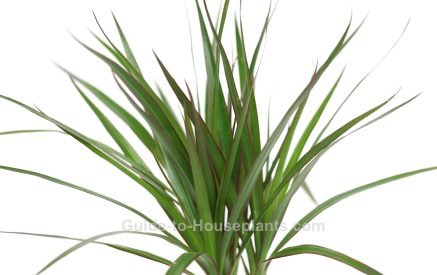
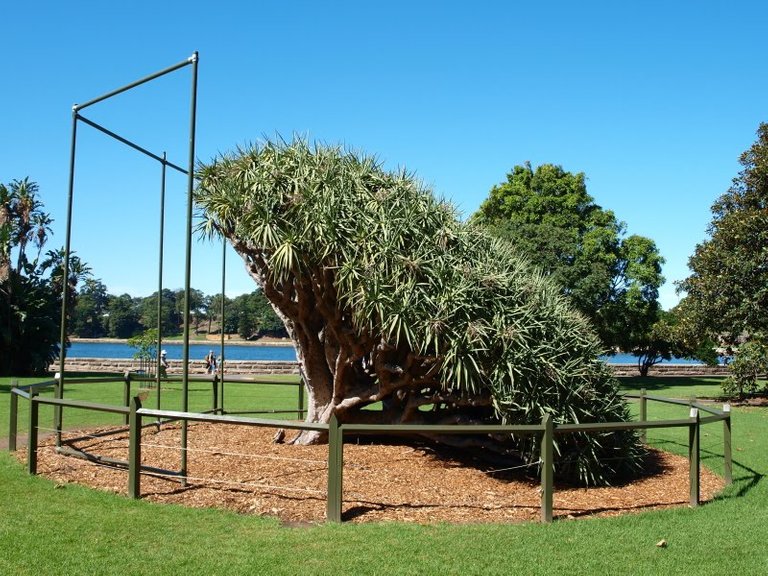
dragon tree, dracaena marginata
This beautiful tree starts out as a thick tuft of spiky leaves. As it grows, the lower leaves naturally fall, leaving a cluster of dramatic, spear-shaped leaves above a bare woody stem. Its narrow, red-edged leaves can grow about 12-16 in (30-40 cm) long.
Clean it up. Those tall, upright leaves tend to be dust-catchers. If possible, take the plant outdoors when the weather permits and gently spray the leaves with tepid water. Or wipe them off with a damp cloth.
Keep it short. Slow-growing, this exotic house plant will eventually reach 6 ft (1.8 m) tall indoors. You can control its height by simply cutting off the top.
Take a stand. Give a young plant a boost by placing it on an indoor plant stand. The tall, spiky leaves of the dragon tree looks spectacular by itself on a pedestal stand. Or combine it with shrubby and trailing plants for contrast. Take a look at these new ways to display your indoor plants.
 http://www.guide-to-houseplants.com/dragon-tree.html
http://www.guide-to-houseplants.com/dragon-tree.html
Amazing trees!
Thank you for telling us about them, @ctrl-alt-nwo
Deciduous-decorative dracaena is known to many, but not everyone knows that the "ancestor" of this amazing plant is a relict plant.
This succulent is a relative of the cactus.
I read that according to the legend of the Guanches, the first trees grew on the blood of the dragon, who died in a fight with a fearless and strong elephant.
source